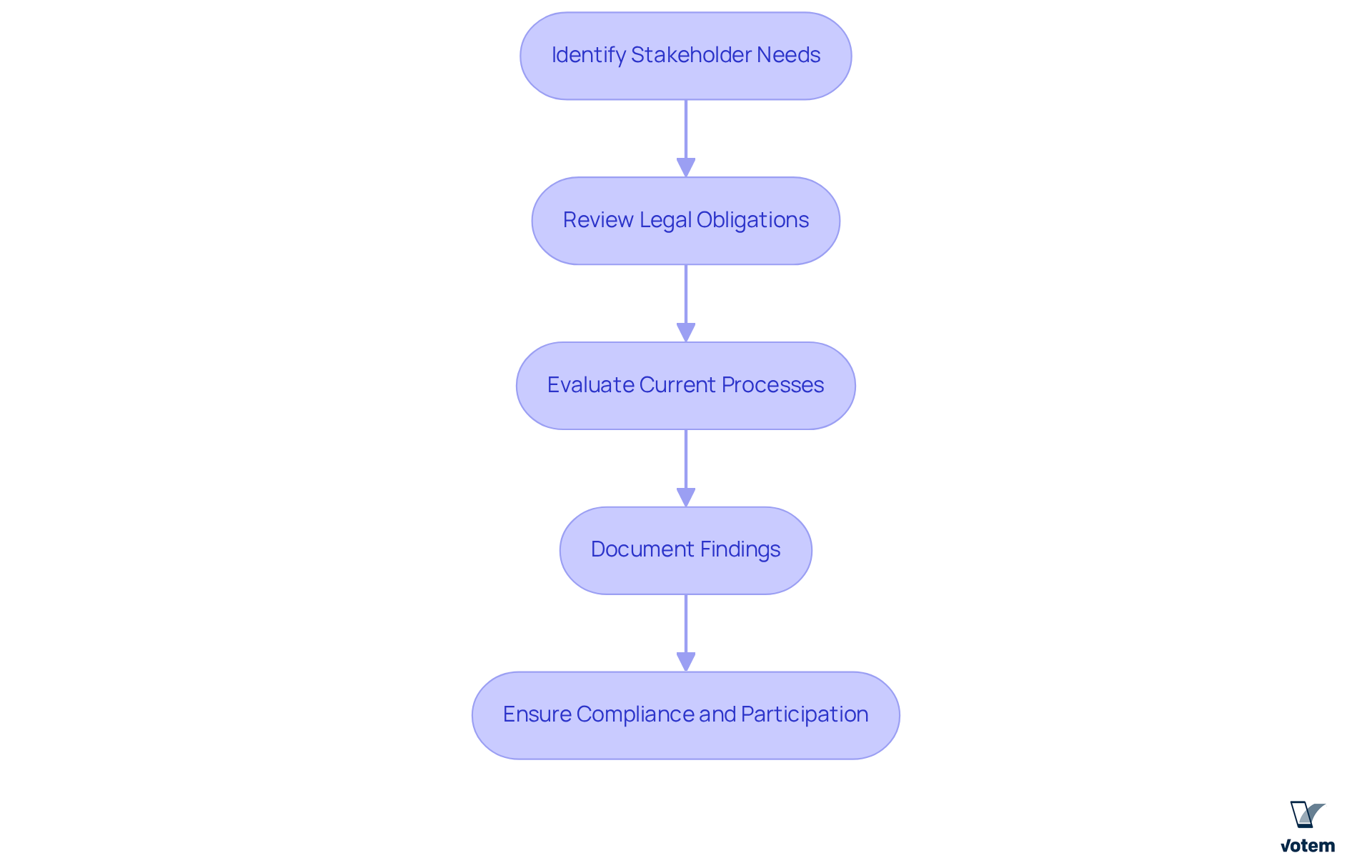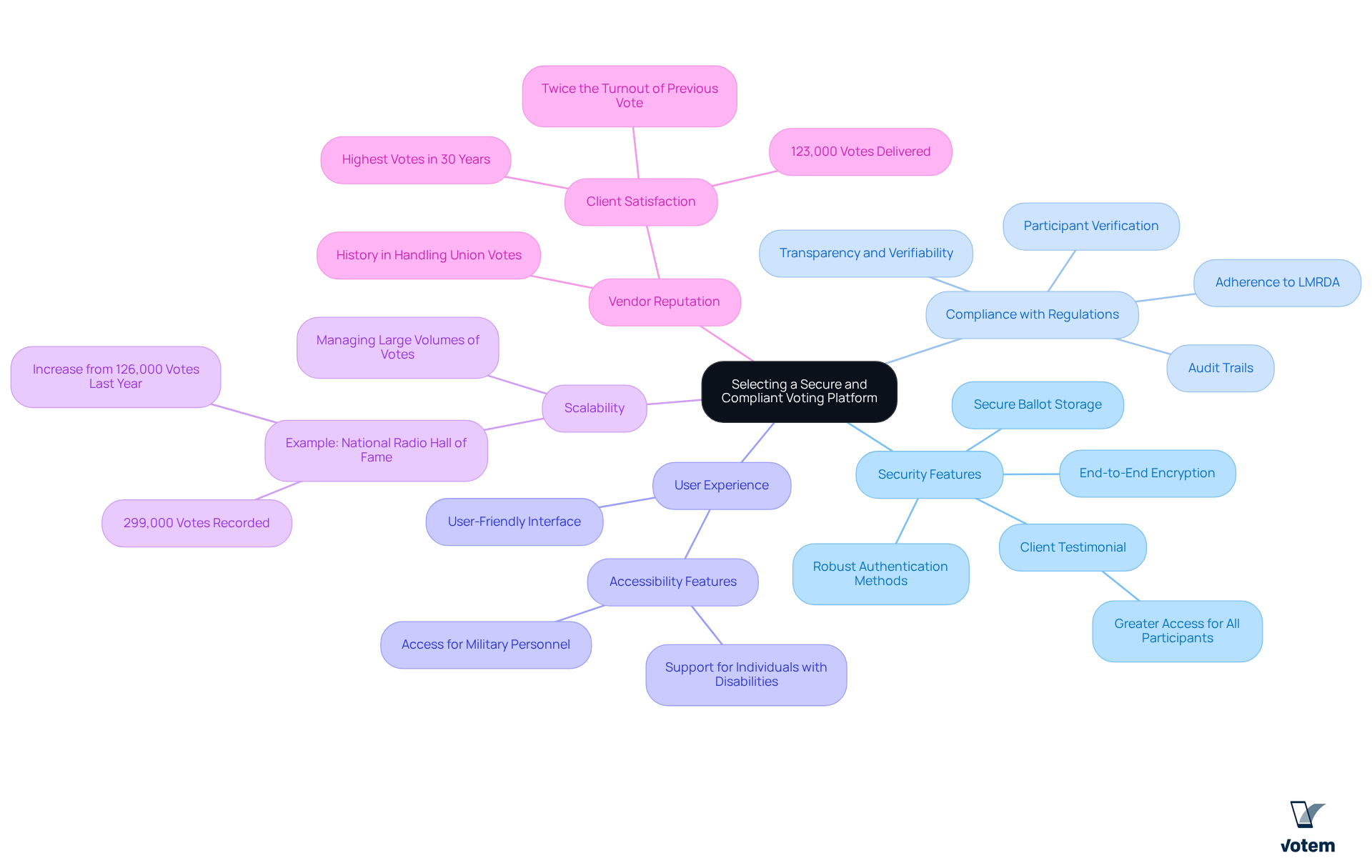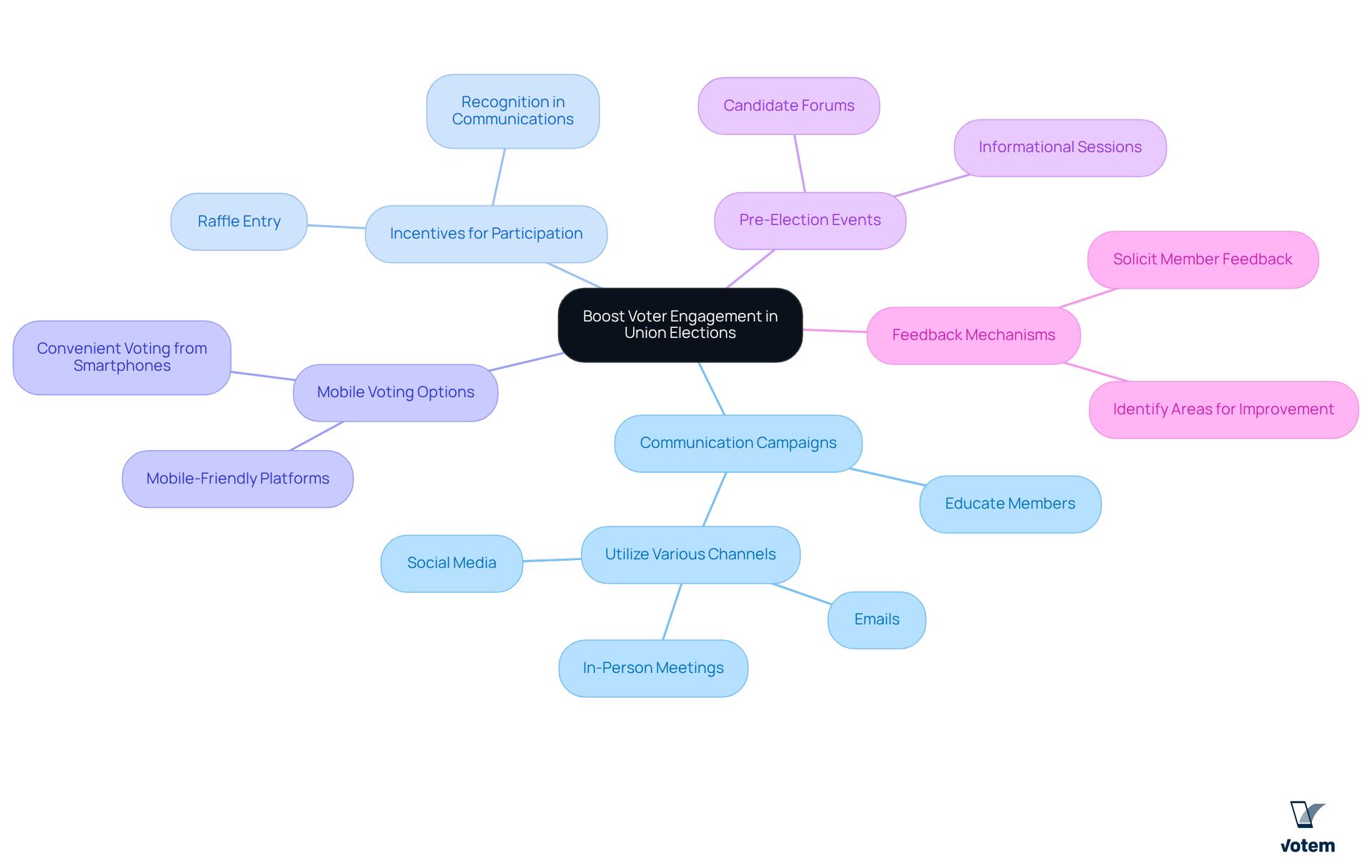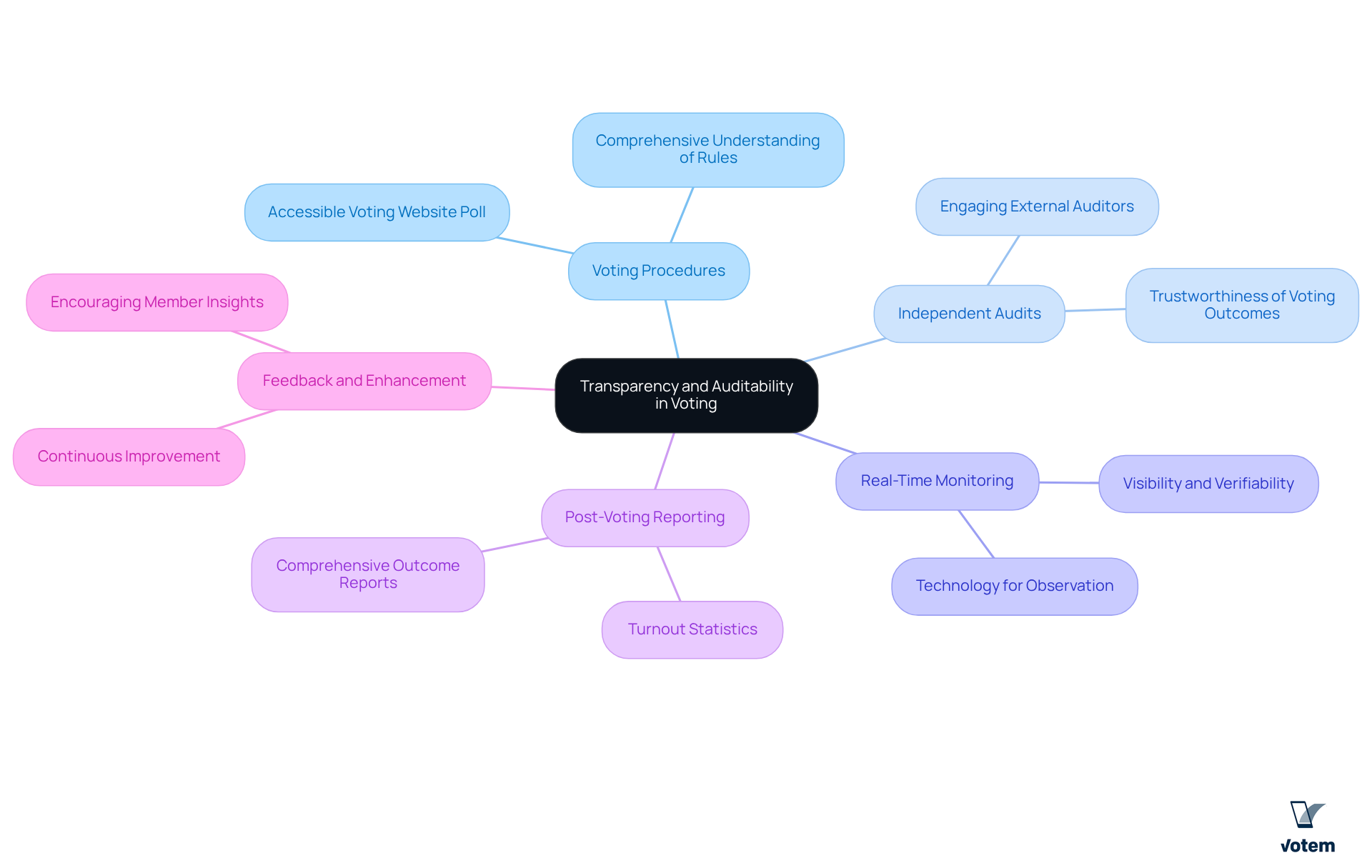Overview
The article emphasizes best practices for establishing a secure voting website poll in unions, highlighting the critical need to assess union requirements, select compliant platforms, and engage voters effectively. This focus on security is vital in fostering trust and participation in the electoral process. To achieve this, it outlines essential steps including:
- Understanding legal requirements
- Implementing robust security features
- Enhancing voter engagement through targeted communication campaigns and incentives
These measures are crucial for creating an environment where union members feel confident in the electoral process.
Furthermore, understanding the legal landscape is imperative for union leadership. By ensuring compliance with regulations, unions can avoid potential pitfalls that may undermine the voting process. Implementing security features not only protects the integrity of the poll but also reassures voters that their voices matter. In addition, enhancing voter engagement through well-crafted communication strategies and incentives can significantly increase participation rates, making it essential for unions to prioritize these initiatives.
In conclusion, the article serves as a comprehensive guide for union leadership, providing actionable insights into securing voting processes. By adopting these best practices, unions can foster an atmosphere of trust and encourage active participation among their members, ultimately strengthening the democratic process within their organizations.
Introduction
Navigating the complexities of online voting in unions demands a careful balance of security, compliance, and member engagement. As labor organizations increasingly adopt digital solutions, it becomes essential to understand best practices for creating a secure voting website. What measures can unions implement to safeguard the integrity of their elections while fostering a culture of participation among their members? This article delves into critical steps and strategies that can enhance the electoral process, ensuring that every voice is heard and every vote is counted.
Assess Union Needs and Legal Requirements
Before implementing an online voting system, leaders must conduct a comprehensive assessment of their specific needs alongside the legal requirements governing their elections. This procedure should encompass a thorough understanding of the Labor-Management Reporting and Disclosure Act (LMRDA) and any applicable state regulations. Key steps include:
- Identify Stakeholder Needs: Engage with collective members to gather insights on their preferences and concerns regarding the voting process, ensuring that their voices are heard.
- Review Legal Obligations: Consult with legal experts to confirm compliance with all relevant laws, particularly those pertaining to secret ballots and voter eligibility, as mandated by the LMRDA.
- Evaluate Current Processes: Analyze existing voting methods to pinpoint areas for enhancement, focusing on improving accessibility and security. This evaluation is crucial, as studies indicate that a significant percentage of associations conduct needs assessments for their voting systems to ensure compliance and effectiveness.
- Document Findings: Compile a detailed report that outlines the organization’s needs and legal requirements. This documentation will serve as a vital reference for selecting an appropriate voting platform.
By adhering to these steps, organizations can guarantee that their voting methods not only meet compliance standards but also align with member expectations in the voting website poll, thereby fostering trust and encouraging participation in the electoral system. This proactive approach is crucial, particularly considering recent guidance highlighting the significance of preserving anonymity for participants and the integrity of the voting process.

Select a Secure and Compliant Voting Platform
Selecting a secure and compliant voting website poll is a pivotal step in conducting union elections. Key considerations include:
-
Security Features: Look for platforms that provide end-to-end encryption, secure ballot storage, and robust authentication methods to safeguard participant data. Votem’s innovative solutions guarantee that all electoral information is protected, thereby enhancing trust in the voting website poll process. As remarked by a pleased client, “Implementing Votem’s new, modern system which allowed greater access for all qualified participants from military personnel to individuals with disabilities was my greatest accomplishment in office.”
-
Compliance with Regulations: Ensure the platform adheres to LMRDA and other relevant regulations, providing features that facilitate compliance, such as audit trails and participant verification. Votem’s commitment to transparency and verifiability through their voting website poll supports unions in meeting these regulatory requirements.
-
User Experience: Choose a platform that is user-friendly and accessible, accommodating all members, including those with disabilities. Votem’s systems are designed to enhance accessibility, ensuring that every qualified voter can participate, from military personnel to individuals with disabilities.
-
Scalability: The platform should be capable of managing varying amounts of votes, particularly during peak voting seasons. Votem has effectively managed large-scale voting processes, as demonstrated by their handling of a voting website poll that recorded 299,000 votes for the National Radio Hall of Fame, which marked an increase over last year’s 126,000 votes received.
-
Vendor Reputation: Investigate the vendor’s history in handling union votes and their dedication to security and compliance. Votem has a proven history of providing dependable electoral systems, as emphasized by pleased clients who have witnessed enhanced voter participation and satisfaction. One client stated, “Votem assisted in delivering 123,000 votes, more than twice the turnout of the previous vote in 2015 and the highest number of votes since the process started 30 years ago!”
By thoughtfully assessing these factors, labor organizations can choose a platform that not only fulfills their requirements but also improves the overall integrity of the electoral system.

Implement Strategies to Boost Voter Engagement
To significantly boost voter engagement in union elections, it is imperative to implement targeted strategies that resonate with members.
-
Communication Campaigns: Establish focused communication strategies that not only educate members about the election procedures and candidates but also emphasize the importance of their vote. Utilize a variety of channels—emails, social media, and in-person meetings—to ensure comprehensive outreach.
-
Incentives for Participation: Consider offering compelling incentives for voting, such as entry into a raffle or recognition in union communications. This approach can motivate members to participate actively in the electoral process.
-
Mobile Voting Options: Leverage mobile-friendly voting platforms to facilitate convenient voting from smartphones. This enhances accessibility and can lead to increased participation among members.
-
Pre-Election Events: Organize engaging informational sessions or candidate forums that actively involve members. Such initiatives can inspire and motivate them to take part in the electoral activities.
-
Feedback Mechanisms: After the election, it is crucial to solicit feedback from members regarding their voting experience. This input can help identify areas for enhancement in future ballots, ensuring continuous improvement.
By actively involving members and making the voting website poll more accessible, organizations can not only increase turnout but also foster a culture of participation that strengthens the union’s democratic processes.

Ensure Transparency and Auditability in Voting
To ensure transparency and auditability in union elections, it is imperative to implement the following best practices:
-
Voting procedures and rules must be made available to all members through a voting website poll, ensuring a comprehensive understanding of the electoral process. Votem’s modern system significantly enhances accessibility for all qualified voters participating in the voting website poll, including military personnel and individuals with disabilities. This inclusivity is crucial for fostering a fair electoral environment.
-
Independent Audits: Engaging external auditors to assess the voting system and outcomes adds a vital layer of trustworthiness. This practice is essential for ensuring transparency and auditability, which aligns with Votem’s commitment to secure and transparent voting website poll solutions. Their successful management of 299,000 votes for the National Radio Hall of Fame exemplifies this, significantly increasing participation compared to previous years.
-
Real-Time Monitoring: Utilizing technology that allows for real-time observation of the voting system empowers stakeholders to monitor the ballot as it unfolds. Votem’s innovative platform facilitates the voting website poll capability, ensuring that every aspect of the voting process remains visible and verifiable.
-
Post-Voting Reporting: After the vote, it is crucial to provide a comprehensive report detailing the outcomes, including turnout statistics and any discrepancies noted during the procedure. For instance, Votem’s assistance in delivering 123,000 ballots in a recent voting website poll more than doubled the turnout from the previous contest, showcasing the effectiveness of their solutions in enhancing participation.
-
Feedback and Enhancement: Encouraging members to share their insights on the election procedure is essential for continuous improvement. The New Mexico State Republican Party’s positive experience with Votem’s software underscores the importance of leveraging user feedback to enhance future elections.
By prioritizing transparency and auditability, unions can bolster voter confidence and ensure that the electoral process is perceived as fair and legitimate. Leveraging Votem’s innovative solutions is key to achieving these critical goals.

Conclusion
Implementing a secure voting website poll in unions is a multifaceted process that necessitates careful consideration of various factors. It is crucial to assess union needs and legal requirements, select a compliant and secure voting platform, boost voter engagement, and ensure transparency and auditability throughout the electoral process. Each of these elements plays a pivotal role in fostering trust and participation among union members, ultimately strengthening the democratic process.
Engaging stakeholders to understand their preferences is essential. Choosing a platform that adheres to legal standards while providing robust security features is significant. Furthermore, implementing strategies to enhance voter participation adds value. The need for transparency through independent audits and real-time monitoring cannot be overstated, ensuring that the voting process is not only secure but also perceived as fair and legitimate.
By prioritizing these best practices, unions can create an electoral environment that meets compliance standards and encourages active member participation. The importance of secure and transparent voting directly impacts the integrity of the union’s democratic processes. Embracing these strategies not only enhances voter confidence but also promotes a culture of engagement, ensuring that every member’s voice is heard and valued in the decision-making process.
Frequently Asked Questions
What is the first step before implementing an online voting system for unions?
The first step is to conduct a comprehensive assessment of specific needs alongside the legal requirements governing elections, including understanding the Labor-Management Reporting and Disclosure Act (LMRDA) and applicable state regulations.
How can union leaders identify stakeholder needs?
Union leaders can identify stakeholder needs by engaging with collective members to gather insights on their preferences and concerns regarding the voting process, ensuring that their voices are heard.
Why is it important to review legal obligations before implementing an online voting system?
It is important to review legal obligations to confirm compliance with all relevant laws, particularly those related to secret ballots and voter eligibility as mandated by the LMRDA.
What should be evaluated in the current voting processes?
Existing voting methods should be analyzed to identify areas for enhancement, focusing on improving accessibility and security.
What is the purpose of documenting findings during the assessment process?
Documenting findings serves as a vital reference for selecting an appropriate voting platform by outlining the organization’s needs and legal requirements.
How does following these assessment steps benefit organizations?
Following these steps ensures that voting methods meet compliance standards and align with member expectations, thereby fostering trust and encouraging participation in the electoral system.
What recent guidance should organizations consider when implementing an online voting system?
Organizations should consider guidance highlighting the significance of preserving anonymity for participants and maintaining the integrity of the voting process.
List of Sources
- Assess Union Needs and Legal Requirements
- Electing Union Officers Using Remote Electronic Voting Systems (https://dol.gov/agencies/olms/compliance-assistance/tips/remote-electronic-voting-systems)

